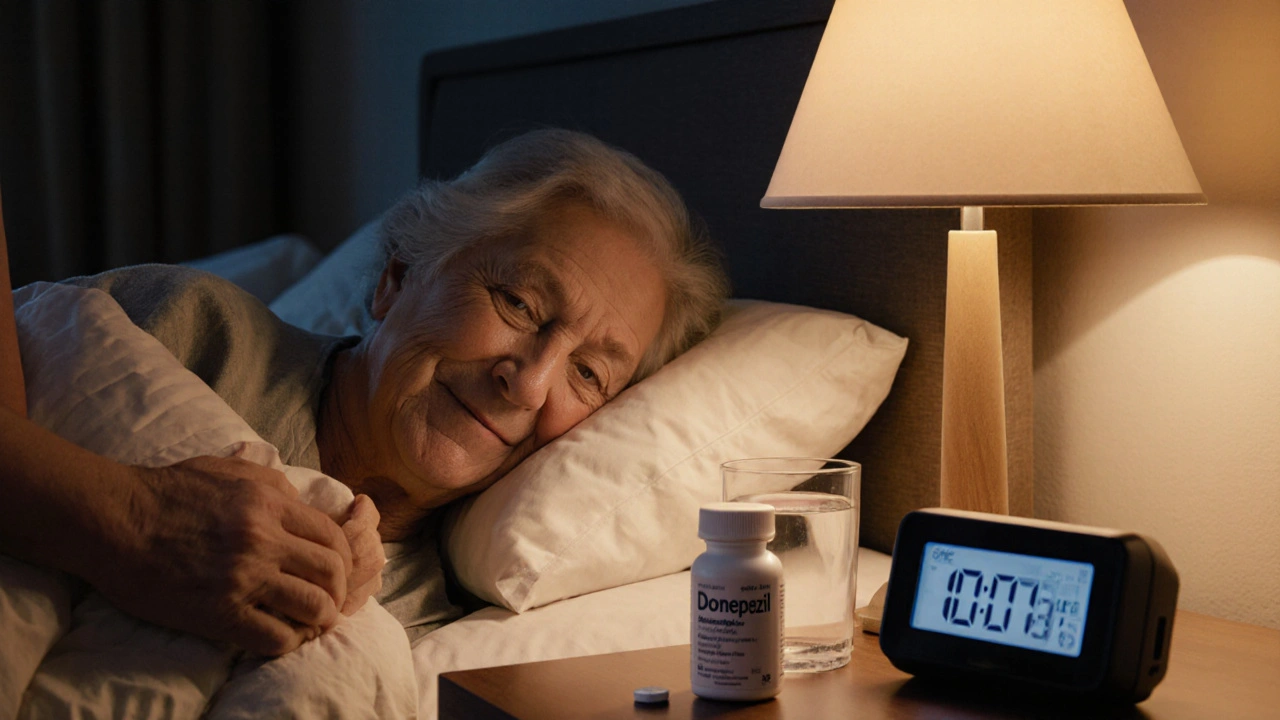Quick Takeaways
- Donepezil (Aricept) is the most prescribed acetylcholinesterase inhibitor for mild‑to‑moderate Alzheimer’s disease.
- Rivastigmine and galantamine offer similar benefits but differ in dosing frequency and side‑effect profiles.
- Memantine works via a separate mechanism (NMDA‑receptor antagonism) and is usually added in moderate‑to‑severe stages.
- Choosing the right drug depends on how your body tolerates stomach upset, liver function, and how often you can take a pill.
- Regular check‑ins with your doctor keep dose adjustments safe and effective.
When families start looking at Alzheimer’s treatments, the name Donepezil is a reversible acetylcholinesterase inhibitor sold under the brand name Aricept Aricept usually lands on the top of the list. But it’s not the only option. Below we break down how Donepezil stacks up against its closest rivals - Rivastigmine, Galantamine, and the NMDA‑receptor antagonist Memantine - so you can decide which medication fits your lifestyle and health profile.
What is Donepezil (Aricept) and How Does It Work?
Donepezil belongs to the class of drugs called acetylcholinesterase inhibitors agents that block the breakdown of acetylcholine, a brain chemical involved in memory and learning. By keeping more acetylcholine available, Donepezil can temporarily improve cognition, delay functional decline, and reduce behavioral symptoms in patients with mild‑to‑moderate Alzheimer's disease a progressive neurodegenerative disorder characterized by memory loss and cognitive impairment.
The standard starting dose is 5mg once daily, usually taken at bedtime. After four to six weeks, doctors often increase to 10mg, and some patients may go up to 23mg for advanced stages. The once‑daily schedule is a big convenience factor for many caregivers.
Alternatives at a Glance
Besides Donepezil, three other prescription agents have solid evidence for Alzheimer’s:
- Rivastigmine an acetylcholinesterase inhibitor that also blocks butyrylcholinesterase, often used when patients have trouble tolerating Donepezil
- Galantamine another acetylcholinesterase inhibitor that also modulates nicotinic receptors, potentially offering extra cognitive boost
- Memantine an NMDA‑receptor antagonist that protects brain cells from excess glutamate, typically added for moderate‑to‑severe disease
All four drugs have FDA approval for Alzheimer’s, but they differ in how they’re taken, side‑effects, and the stage of disease they target best.
Side‑Effect Profiles - What to Expect
Understanding side‑effects helps you match a drug to a patient’s daily routine.
- Donepezil (Aricept): nausea, vomiting, loss of appetite, insomnia, and occasional muscle cramps. Because it’s taken once a day, the stomach upset often settles after the first few weeks.
- Rivastigmine: more gastrointestinal complaints (nausea, diarrhea) and a higher chance of skin rash with the transdermal patch. The patch can be a good alternative for patients who can’t swallow pills.
- Galantamine: stomach upset similar to Donepezil, plus dizziness and occasional weight loss. Dosage is usually twice daily, which can be a drawback for some.
- Memantine: generally well‑tolerated; occasional dizziness, headache, or constipation. Because it works on a different pathway, it’s often combined with an acetylcholinesterase inhibitor for added benefit.
Direct Comparison Table
| Drug | Class | Typical Dose | Common Side Effects | FDA Approval Year | Best For |
|---|---|---|---|---|---|
| Donepezil (Aricept) | Acetylcholinesterase inhibitor | 5mg daily → 10mg → 23mg | Nausea, insomnia, muscle cramps | 1996 | Mild‑to‑moderate Alzheimer’s; once‑daily convenience |
| Rivastigmine | Acetylcholinesterase & butyrylcholinesterase inhibitor | 1.5mg BID → 6mg BID (caps) or 4.6mg/24h patch | Diarrhea, skin rash (patch), nausea | 2000 | Patients with GI sensitivity; patch option for swallowing issues |
| Galantamine | Acetylcholinesterase inhibitor (nicotinic modulator) | 4mg BID → 8mg BID → 12mg BID | Dizziness, weight loss, nausea | 2001 | Those who may benefit from nicotinic modulation; able to take twice‑daily dosing |
| Memantine | NMDA‑receptor antagonist | 5mg daily → 10mg BID → 20mg BID | Dizziness, constipation, headache | 2003 | Moderate‑to‑severe Alzheimer’s; often added to an AChEI |

How to Choose the Right Medication
There’s no one‑size‑fits‑all answer. Below is a quick decision guide you can run with your doctor.
- Once‑daily convenience matters? Donepezil wins.
- Patient struggles with swallowing? Consider the Rivastigmine patch.
- Frequent stomach upset on Donepezil? Switching to Galantamine or a lower dose of Rivastigmine may help.
- Disease has progressed to moderate‑severe? Adding Memantine can provide extra neuroprotection.
- Kidney or liver function is reduced? Dose adjustments are needed for all drugs; Memantine often requires the most careful monitoring.
Always start low and go slow. Most clinicians begin with the lowest effective dose, monitor side‑effects for a month, then titrate up.
Managing Side Effects and Monitoring
Side‑effects rarely disappear on their own without a tweak. Here are practical tips:
- Take the pill with food. This reduces nausea for Donepezil, Galantamine, and oral Rivastigmine.
- Switch timing. If insomnia hits, move Donepezil to the evening.
- Use the patch. For Rivastigmine, the skin can be a source of irritation-rotate sites and keep the area clean.
- Hydration. Diarrhea from Rivastigmine can be eased by fluids and electrolytes.
- Regular labs. Check liver enzymes and kidney function every 3‑6 months for all drugs.
When side‑effects become unbearable, ask your doctor about lowering the dose or swapping to another agent. Most patients find a sweet spot after a few adjustments.
Frequently Asked Questions
Can I take Donepezil and Memantine together?
Yes. The two work on different brain pathways, so doctors often combine them for moderate‑to‑severe Alzheimer’s to boost overall benefit.
How long does Donepezil stay effective?
The medication can maintain modest cognitive benefits for 6‑12 months on average, but individual response varies. Regular check‑ins help decide when to switch or add another drug.
Is the Rivastigmine patch safer than the oral form?
The patch bypasses the stomach, so it often causes fewer GI issues. However, skin irritation can be a concern, so rotate placement sites and watch for rash.
What should I do if my loved one forgets to take the medication?
Set a daily alarm, use a pill organizer, or enlist a caregiver to supervise the dose. Missing a single dose usually isn’t harmful, but consistency matters for best results.
Are there natural alternatives to these prescription drugs?
Lifestyle changes-regular exercise, a Mediterranean‑style diet, social engagement, and good sleep-can slow decline, but they don’t replace the proven benefits of FDA‑approved medications.
By weighing convenience, side‑effects, disease stage, and personal health, you can land on a regimen that feels manageable and effective. Talk openly with your neurologist or primary‑care doctor; they’ll tailor the dose and monitor progress so the chosen drug gives the most benefit with the fewest hassles.


19 Comments
rahul s
Look, if you’re hunting for the silver bullet in dementia care, Donepezil is the flag‑bearing titan of the lot – it’s the drug that Indian doctors proudly prescribe like a national treasure. Its once‑daily regimen makes it a darling for families juggling chaotic schedules, and the side‑effect profile, while not flawless, is manageable with a pinch of traditional dietary wisdom. If you can stomach the occasional nausea, you’ve already conquered half the battlefield. Remember, the real victory lies in consistency, not just the pill.
Natasha Beynon
Thanks for highlighting the convenience factor. It’s also worth noting that regular follow‑ups can catch subtle tolerability issues early, ensuring the patient stays on the optimal dose. A calm, supportive approach at each visit really makes a difference.
Cinder Rothschild
The landscape of Alzheimer’s therapeutics is a tapestry woven with threads of pharmacodynamics and patient individuality; each medication, from Donepezil’s cholinergic boost to Memantine’s glutamatergic modulation, paints a distinct hue on the canvas of cognitive preservation and quality of life, urging clinicians to consider not merely the molecular mechanism but also the rhythmic cadence of dosing schedules, the nuanced tapestry of gastrointestinal tolerability, and the subtle interplay of comorbid organ function, thereby crafting a personalized regimen that resonates with the patient’s daily narrative and cultural backdrop; in practice, this means evaluating the caregiver’s capacity to administer a nightly tablet versus a transdermal patch, weighing the merits of a twice‑daily galantamine for those who can adhere to a strict regimen, and recognizing that the addition of Memantine may herald a strategic escalation in moderate‑to‑severe stages, all while maintaining a vigilant eye on laboratory parameters and side‑effect emergence.
Oscar Brown
One must approach the pharmacotherapeutic armamentarium for Alzheimer’s disease with both scientific rigor and philosophical contemplation, for therein lies the essence of true clinical stewardship. The cholinergic hypothesis, while elegant, remains but a fragment of the intricate neuropathological mosaic, and thus the clinician’s task is to integrate diverse mechanistic insights with empirical evidence. Donepezil, as the prototypical acetylcholinesterase inhibitor, offers a commendable balance of efficacy and dosing simplicity, yet its gastrointestinal adverse profile mandates careful titration and patient education. Rivastigmine’s dual inhibition of butyrylcholinesterase expands its therapeutic horizon, though the necessity of twice‑daily dosing or transdermal application introduces adherence challenges that must be mitigated through caregiver engagement. Galantamine’s nicotinic receptor modulation confers an ancillary cognitive advantage, albeit at the cost of increased dosing frequency and potential dizziness, inviting a nuanced risk‑benefit analysis. Memantine, by antagonizing NMDA receptors, addresses excitotoxic pathways uncharted by cholinergic agents, and its synergistic potential when combined with an AChEI has been substantiated in moderate‑to‑severe cohorts, yet renal clearance considerations impose a vigilant monitoring regimen. The clinician, therefore, must navigate this therapeutic labyrinth with an ethos of patient‑centered care, calibrating dose escalations in a stepwise fashion-beginning with low‐dose initiation, observing for a minimum of four weeks, then judiciously titrating upward while documenting cognitive trajectories and functional outcomes. Moreover, regular laboratory surveillance, encompassing hepatic transaminases and renal function tests, serves as a safeguard against insidious toxicity. In practice, the decision matrix is further complicated by comorbidities such as cardiovascular disease, which may predispose patients to orthostatic hypotension when combined with certain agents. Equally, the psychosocial dimension cannot be overlooked; caregivers’ capacity to manage a regimen, their health literacy, and cultural attitudes toward medication adherence profoundly influence therapeutic success. Ultimately, the art of Alzheimer’s pharmacotherapy resides in the synthesis of pharmacodynamic principles, patient-specific variables, and the ethical imperative to preserve dignity and autonomy for as long as possible.
Tommy Mains
If you’re looking for a straightforward rundown, start with the lowest effective dose and watch for side effects. Donepezil’s once‑daily schedule is a win for most caregivers. Keep an eye on liver enzymes, especially if you bump up to 23 mg.
Benjamin Hamel
While the consensus leans toward Donepezil for its convenience, one could argue that the patch form of Rivastigmine sidesteps the most common GI complaints, albeit at the expense of skin irritation. Moreover, the pharmacokinetic profile of Galantamine suggests a potential advantage in patients with subtle nicotinic deficits. Yet, the data is not unequivocal, and the clinician must weigh each nuance. In short, there’s no one‑size‑fits‑all, and the art lies in individualized assessment.
Christian James Wood
Honestly, the hype around these meds often masks the emotional toll on families. Donepezil can feel like a lifeline, but the nightly nausea can drive anyone to despair. Switches to Galantamine aren’t always smooth; the dizziness can be brutal. And let’s not forget that Memantine, while well‑tolerated, sometimes feels like a placebo for severe cases. Bottom line: manage expectations and support the caregivers.
Rebecca Ebstein
Totally get you, it’s tough. I’ve seen patients bounce between Donepezil and Rivastigmine patches with mixed results. The key is patience and a good support system.
Artie Alex
From a clinical informatics perspective, the polypharmacy risk escalates when adding Memantine to acetylcholinesterase inhibitors, demanding a rigorous medication reconciliation protocol. Moreover, the neuropharmacological synergy, while theoretically advantageous, lacks robust longitudinal data to substantiate widespread adoption. In practice, the cost–benefit calculus must factor in insurance formularies and patient out‑of‑pocket expenditures, which can be prohibitive. Therefore, a judicious, evidence‑based approach is paramount.
abigail loterina
Great summary! I’d add that involving a multidisciplinary team, including a pharmacist, can really streamline dose adjustments. It’s often the little details that make the biggest difference.
Roger Cole
Check labs regularly.
Krishna Garimella
The philosophical underpinnings of memory loss intersect with the biochemical reality of neurotransmitter deficits; thus, prescribing Donepezil is not merely a mechanistic act but a gesture toward preserving the narrative self. In everyday practice, we balance the theoretical benefits against the lived experience of the patient – a delicate dance of dosing, timing, and side‑effect management. The caregiver’s role becomes an extension of the therapeutic regimen, reminding the patient to take the pill, monitoring for nausea, and adjusting the schedule as needed. When tolerability falters, we pivot to Rivastigmine patches, honoring the patient’s autonomy while mitigating gastrointestinal distress. The integration of Memantine at later stages represents an acknowledgment of disease progression, adding neuroprotective scaffolding to the cholinergic foundation. Ultimately, a patient‑centered approach, rooted in empathy and scientific clarity, yields the most humane outcomes.
nalina Rajkumar
👍 Donepezil works well for many🤝
🌟 Keep an eye on side effects!
Daisy Aguirre
Donepezil’s daily simplicity is a godsend for busy families, yet its stomach upset can be a real pain‑in‑the‑neck. Rivastigmine patches provide a sleek alternative, especially for those who can’t swallow pills, but watch for skin rash. Galantamine offers a cognitive boost with nicotinic modulation, though the twice‑daily schedule can be a chore. Memantine shines in moderate‑to‑severe stages, adding neuroprotection without the cholinergic baggage.
Natalie Kelly
Love the clear guide!
Just remember to keep the meds handy!
Tiffany Clarke
Side effects are inevitable, but they’re manageable with simple tweaks.
Andy V
Grammatically speaking, the article correctly uses parallel structure in the comparison table. However, the phrase “once‑daily convenience matters?” should be rephrased to avoid a dangling question. Consistency in capitalization of drug names is also essential.
Tammie Sinnott
Wow, this breakdown is like a roadmap through a maze! I love how it balances science with practical tips. It’s so helpful for families feeling lost in the sea of options.
Michelle Wigdorovitz
Reading this feels like attending a masterclass-insightful, thorough, and surprisingly approachable. The focus on caregiver strategies adds a human touch often missing from clinical guides. Kudos to the author for weaving clarity with compassion.